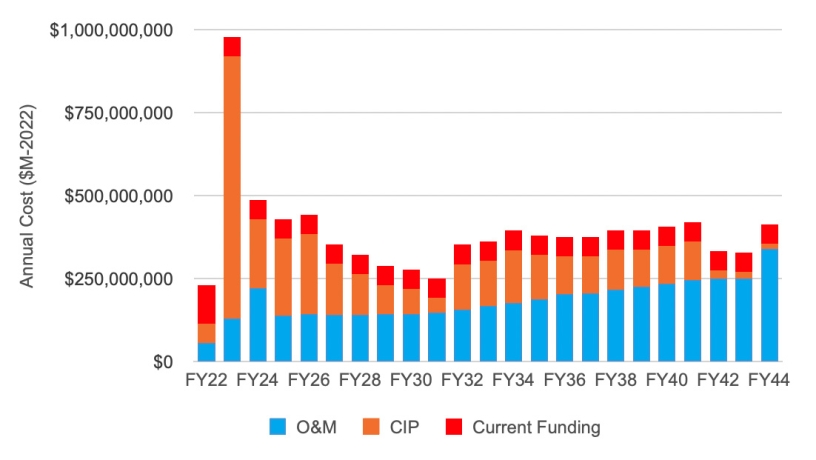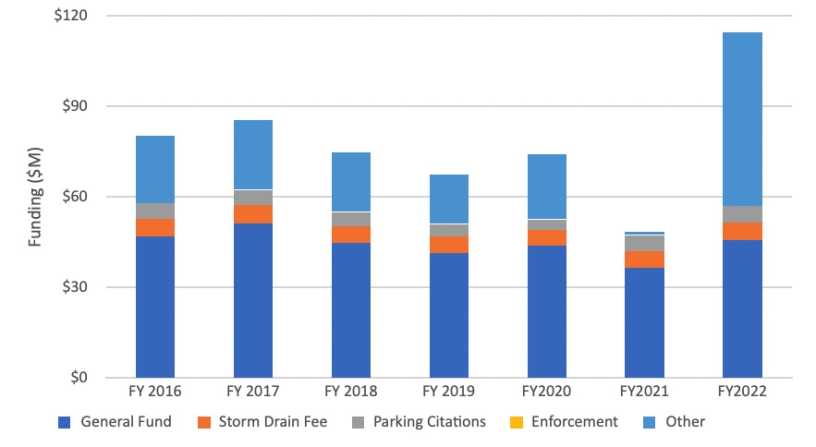Action Strategy
Stormwater Challenges Mounting Rapidly
The City of San Diego’s Stormwater Department faces a significant and growing funding gap – currently about $274 million annually – that cannot be filled with existing revenue sources. The City hasn’t increased fees for stormwater service in over 25 years and, during that time, the department implemented several cost-saving measures and operational efficiencies that allowed it to limp forward.
If nothing is done, there may be significant consequences as the City’s aging stormwater system – pipes, drains, channels, levees and pumps – continues to fail at an increasingly higher rate. A failure of even one key piece of infrastructure could result in the flooding of an entire neighborhood, damaging homes and businesses.
How do we fix this problem? Raising new revenue for stormwater services through a parcel tax or a property-related fee requires a public vote. The Stormwater Department continues to evaluate the potential viability of a future ballot measure that would generate new revenue and help ensure clean water and clean beaches for all of San Diego. Check out the latest update on the progress as well as previous reports.
Action Needed to Avoid Crisis
A recent audit found current funding levels insufficient to handle growing stormwater responsibilities and demanded action. In response, the City is developing a funding strategy to pay for the system’s current and future needs. Check out the latest update as well as past reports.
Stormwater Department’s Strategic Plan
February 2022 Final Audit Response
The Funding Gap
The Stormwater Department is responsible for protecting local waterways and the ocean from pollution and for operating, maintaining and modernizing the City’s vast stormwater system. While much of that system is hidden underground, obscured from public view, this infrastructure is essential to San Diegan’s quality of life, health and safety.
The limited funding sources currently in place to pay for those stormwater responsibilities are simply not enough. Several factors have led to the need for additional revenue, including increasingly strict water quality requirements, aging and failing infrastructure, a changing climate with more extreme weather events, and urbanization.
This chart shows the Stormwater Department’s annual funding needs over the next 20 years for operations and maintenance (O&M) and capital improvement projects (CIP) to modernize the aging system. The average annual gap is $274 million – meaning each year the City will have $274 million less than it needs to properly operate, maintain and upgrade the system.
Funding Needs Continue to Grow

Existing Funding Sources for Stormwater Operations
The limited revenue sources available for the Stormwater Department have forced the City to tap its operating budget to cover emergency repairs. In 2021, there were 11 emergency repair projects that cost over $9 million – none of which were originally in the budget. This leaves less money available for other City priorities, such as public safety, parks and libraries.
Below is a breakdown of existing funding sources for the Stormwater Department by fiscal year. Sources include the City’s operating budget (General Fund); state and federal loans and grants; and storm drain fees paid by businesses and property owners. In addition, the department collects revenue through parking enforcement for street sweeping as well as business and residential inspections.
Stormwater Funding Failing to Keep Pace

Pursuing a Long-term Funding Source
The Stormwater Department continues to assess and refine a potential stormwater funding measure by analyzing various options. It has conducted public opinion research, engaged with interested parties on possible scenarios, and revamped its public education and outreach campaign – Think Blue San Diego. Potential elements of a funding measure include:
- Public Vote: Proposition 218 requires local governments to secure voter approval before raises taxes. A general tax or citizen initiative must win of over 50% of voters while a special tax solely for a specific issue requires over two-thirds approval.
- Special Tax: This funding mechanism could be used to levy a parcel tax on each applicable property and the revenue generated could only be used on the stormwater system. It would require approval by over two-thirds of voter.
- Impermeable Area Basis: This method could be applied to levy a tax on properties based on the square footage of hard surfaces, or impermeable area, that cannot absorb rainwater like roofs, concrete and pavement.
- Stormwater Goals: The potential measure would further the department’s goals to improve water quality, prevent flooding, modernize infrastructure for a changing climate, revitalize our waterways and capture stormwater for reuse.